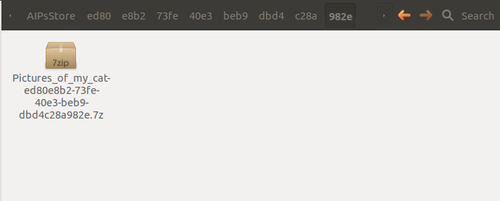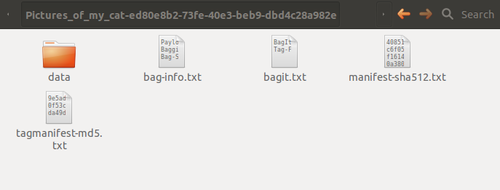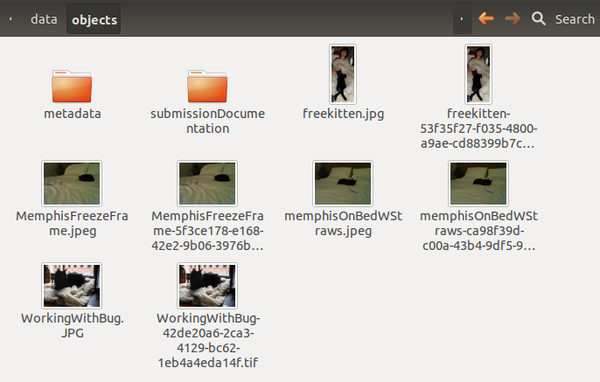Difference between revisions of "AIP structure"
Jump to navigation
Jump to search
m (→Name) |
(→Data) |
||
| (48 intermediate revisions by 3 users not shown) | |||
| Line 1: | Line 1: | ||
[[Main Page]] > [[Development]] > [[:Category:Development documentation|Development documentation]] > AIP structure | [[Main Page]] > [[Development]] > [[:Category:Development documentation|Development documentation]] > AIP structure | ||
| − | + | This page documents the structure of the AIP produced by Archivematica. | |
==Name== | ==Name== | ||
| Line 10: | Line 10: | ||
#a UUID assigned during SIP formation | #a UUID assigned during SIP formation | ||
| − | '''example''': | + | '''example''': Pictures_of_my_cat-aebbfc44-9f2e-4351-bcfb-bb80d4914112 |
| − | " | + | "Pictures_of_my_cat" is the name assigned by the user and "aebbfc44-9f2e-4351-bcfb-bb80d4914112" is the UUID generated during SIP formation. |
| + | |||
| + | </br> | ||
==Directory Structure== | ==Directory Structure== | ||
| − | [[Image: | + | [[Image:ZippedAIP-10.png|500px|right|thumb|'''Figure 1''' AIP directory - top level]] |
| + | |||
| + | * The AIP is zipped in the AIPsStore. The AIP directories are broken down into UUID quad directories* for efficient storage and retrieval. (*UUID quad directories: Some file systems limit the number of items allowed in a directory, Archivematica uses a directory tree structure to store AIPs. The tree is based on the AIP UUIDs. The UUID is broken down into manageable 4 character pieces, or "UUID quads", each quad representing a directory. The first four characters (UUID quad) of the AIP UUID will compose a sub directory of the AIP storage. The second UUID quad will be the name of a sub directory of the first, and so on and so forth, until the last four characters (last UUID Quad) create the leaf of the AIP store directory tree, and the AIP with that UUID resides in that directory.)('''figure 1''') | ||
| + | |||
| + | </br> | ||
| + | |||
| + | ===BagIt documentation=== | ||
| + | |||
| + | *The AIP is packaged in accordance with the [http://www.digitalpreservation.gov/documents/bagitspec.pdf| Library of Congress Bagit specification] (PDF, 84KB) In '''figure 2''', the BagIt files are bag-info.txt, bagit.txt, manifest-sha512.txt and tagmanifest-md5.txt. | ||
| + | [[File:BagSpec-10.png|500px|thumb|'''Figure 2''']] | ||
| + | </div> | ||
| + | |||
| + | <div class="clearfix"> | ||
| + | |||
| + | </div> | ||
| + | *The following describes the contents of the AIP once extracted. | ||
| + | |||
| + | </br> | ||
| − | + | ===Data=== | |
| − | + | [[Image:AIPdatadirectory-10.png|600px|right|thumb|'''Figure 3''' AIP data directory]] | |
| + | The '''data''' directory consists of the [[METS|METS file]] for the AIP and three folders: logs, objects. and thumbnails. (See '''figure 3''') | ||
</div> | </div> | ||
| + | |||
| + | |||
<div class="clearfix"> | <div class="clearfix"> | ||
| + | |||
| + | </div> | ||
| + | *[[METS|METS file]]: /data/METS.uuid.xml contains the full PREMIS implementation (see [[PREMIS metadata: original files|PREMIS metadata for original file]], [[PREMIS metadata: normalized files|PREMIS metadata: normalized files]], [[PREMIS metadata: events|PREMIS metadata: events]], and [[PREMIS metadata: rights|PREMIS metadata: rights]] The role of the METS file is to link original objects to their preservation copies and to their descriptions and submission documentation, as well as to link PREMIS metadata to the objects in the AIP. | ||
</div> | </div> | ||
| − | + | <div class="clearfix"> | |
| − | [[Image: | + | </div> |
| − | + | ||
| + | *Logs: /data/logs contains the /transfers directory, normalization log, malware scan log, and the extraction log (from unpackaging packages) generated during SIP creation. (See '''figure 4''') | ||
| + | **The /transfers directory contains the logs from processing that occurred to each transfer which is part of the SIP in the transfer workflow in the dashboard. | ||
| + | |||
| + | [[Image:DataLogs-10.png|600px|thumb|'''Figure 4''' Logs folder content in Data]] | ||
| + | </div> | ||
| + | |||
| + | <div class="clearfix"> | ||
| + | |||
| + | </div> | ||
| + | |||
| + | *Objects: /data/objects contains original objects, normalized objects, /metadata and /submissionDocumentation. If there were any lower level directories within the SIP, that directory structure is maintained. (See '''Figure 5''' ) | ||
| + | **/metadata contains /transfers, which contains any metadata which may have been imported with the transfers | ||
| + | **/submissionDocumentation contains submission documentation for each transfer which is part of the SIP and each transfer's METS.xml file. The structmap for the transfer is the closest approximation of original order for the transfer. | ||
| + | |||
| + | [[Image:DataObjects-10.png|600px|thumb|'''Figure 5''' Objects folder content in Data]] | ||
| + | </div> | ||
| + | |||
| + | <div class="clearfix"> | ||
| + | |||
| + | </div> | ||
| − | * | + | *Thumbnails: /data/thumbnails contains any thumbnails generated for viewing in the AIP search interface of the dashboard. |
| − | |||
| − | |||
| − | |||
[[Category:Development documentation]] | [[Category:Development documentation]] | ||
Revision as of 13:47, 14 April 2014
Main Page > Development > Development documentation > AIP structure
This page documents the structure of the AIP produced by Archivematica.
Name
The AIP name is composed of the following:
- Either the name of the original transfer if no new name has been assigned to the SIP upon formation or the name of the SIP or SIPs created from the transfer and
- a UUID assigned during SIP formation
example: Pictures_of_my_cat-aebbfc44-9f2e-4351-bcfb-bb80d4914112
"Pictures_of_my_cat" is the name assigned by the user and "aebbfc44-9f2e-4351-bcfb-bb80d4914112" is the UUID generated during SIP formation.
Directory Structure
- The AIP is zipped in the AIPsStore. The AIP directories are broken down into UUID quad directories* for efficient storage and retrieval. (*UUID quad directories: Some file systems limit the number of items allowed in a directory, Archivematica uses a directory tree structure to store AIPs. The tree is based on the AIP UUIDs. The UUID is broken down into manageable 4 character pieces, or "UUID quads", each quad representing a directory. The first four characters (UUID quad) of the AIP UUID will compose a sub directory of the AIP storage. The second UUID quad will be the name of a sub directory of the first, and so on and so forth, until the last four characters (last UUID Quad) create the leaf of the AIP store directory tree, and the AIP with that UUID resides in that directory.)(figure 1)
BagIt documentation
- The AIP is packaged in accordance with the Library of Congress Bagit specification (PDF, 84KB) In figure 2, the BagIt files are bag-info.txt, bagit.txt, manifest-sha512.txt and tagmanifest-md5.txt.
- The following describes the contents of the AIP once extracted.
Data
The data directory consists of the METS file for the AIP and three folders: logs, objects. and thumbnails. (See figure 3)
- METS file: /data/METS.uuid.xml contains the full PREMIS implementation (see PREMIS metadata for original file, PREMIS metadata: normalized files, PREMIS metadata: events, and PREMIS metadata: rights The role of the METS file is to link original objects to their preservation copies and to their descriptions and submission documentation, as well as to link PREMIS metadata to the objects in the AIP.
- Logs: /data/logs contains the /transfers directory, normalization log, malware scan log, and the extraction log (from unpackaging packages) generated during SIP creation. (See figure 4)
- The /transfers directory contains the logs from processing that occurred to each transfer which is part of the SIP in the transfer workflow in the dashboard.
- Objects: /data/objects contains original objects, normalized objects, /metadata and /submissionDocumentation. If there were any lower level directories within the SIP, that directory structure is maintained. (See Figure 5 )
- /metadata contains /transfers, which contains any metadata which may have been imported with the transfers
- /submissionDocumentation contains submission documentation for each transfer which is part of the SIP and each transfer's METS.xml file. The structmap for the transfer is the closest approximation of original order for the transfer.
- Thumbnails: /data/thumbnails contains any thumbnails generated for viewing in the AIP search interface of the dashboard.




